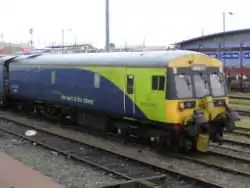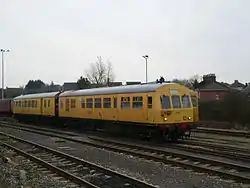British Rail Class 901
The Class 901 designation is used for two former British Rail Class 101 diesel multiple units converted for departmental use. They were reclassified from the Class 960 series in early 2004 by their owner Network Rail.
| British Rail Class 901 | |
|---|---|
 901001 at RVE Derby on 28 September 2007. | |
| In service | 1986-2012 |
| Operator(s) | Network Rail |
| Specifications | |
| Electric system(s) | 750 V DC third rail |
| Track gauge | 1,435 mm (4 ft 8 1⁄2 in) standard gauge |

The two units are described below.
901001
This unit was converted in 1986 from a Class 101 power-twin unit. It was rebuilt as an Ultrasonic Test Train, replacing the former-Derby Lightweight unit that was previously used for this task. The unit was substantially rebuilt, including new headlight clusters, sealing of many windows, and later fitting of video and floodlight equipment for night-time use.
The unit also incorporates a heavily modified former Class 432 4Rep driving motor vehicle, which is now an intermediate trailer.
The Units Class 101 Power Cars are unique, as they are the only first generation DMU cars to have been converted to Air Brakes (both Westinghouse and Electro-Pneumatic). Most of the brake equipment came from former Class 50 Diesel Electric Locomotives, with some parts from ex-Southern Region EMU stock. All first generation DMUs were fitted with vacuum brakes from new.
The Power Cars DB 977391/392 are both now resident on the Churnet Valley Railway, for permanent way use. It is doubtful how much use the unit will get - as it is expensive to run. Both the units engines AND the units in-built generator unit need to be running - the generator provides a 240 VAC supply for the battery charger and compressor (the units original engine driven air pumps would not be able to cope with air demand for air brakes, air ep gear changing valves and the air conditioning units - which also require air.
In addition, special keys are required for the unit - which provide access to the doors, and only certain keys will fit the Drivers control switch.
| DM | T | DM | ||
|---|---|---|---|---|
| 977391 (ex-51433) | + | 999602 (ex-62483) | + | 977392 (ex-53167) |
The unit was originally painted in a unique silver and grey livery. This was replaced by Serco red/grey in the mid-1990s, followed by Railtrack Blue/lime green and finally Network Rail's all-over yellow.
This unit was cut-up on site at Oakamoor February/March 2012.
901002

This unit was converted in 1991, also from a power twin unit. It was rebuilt by the Research & Development Division (R&DD) of British Rail as a test train known as "Lab 19 - Iris II", supplementing the original "Test Coach Iris", which was a former-Derby Lightweight single-car unit. It was used initially for radio survey work particularly with the National Radio Network (NRN) and later for video survey work including extensive signal sighting on the WCML prior to the introduction of 125 mile/h running.
| DM | DM | |
|---|---|---|
| 977692 (ex-53222) | + | 977693 (ex-53338) |
Like 901001, this unit has carried various liveries, starting with BR Research's silver and grey livery, similar to that carried by 901001. This was followed by Serco red/grey, Railtrack Blue/lime green, and most recently the latest Network Rail all-over yellow livery. This unit was withdrawn and stored at Derby's Railway Technical Centre and was sold by Network Rail to a private buyer in early 2008. It didn't stay long at Dunster station on the West Somerset Railway, where it ended up in 2009 being re-painted into BR green. It was intended to be used on Pway trains but in August 2009 moved by road to the Barry Tourist railway where is used daily.
| Wikimedia Commons has media related to British Rail Class 901. |